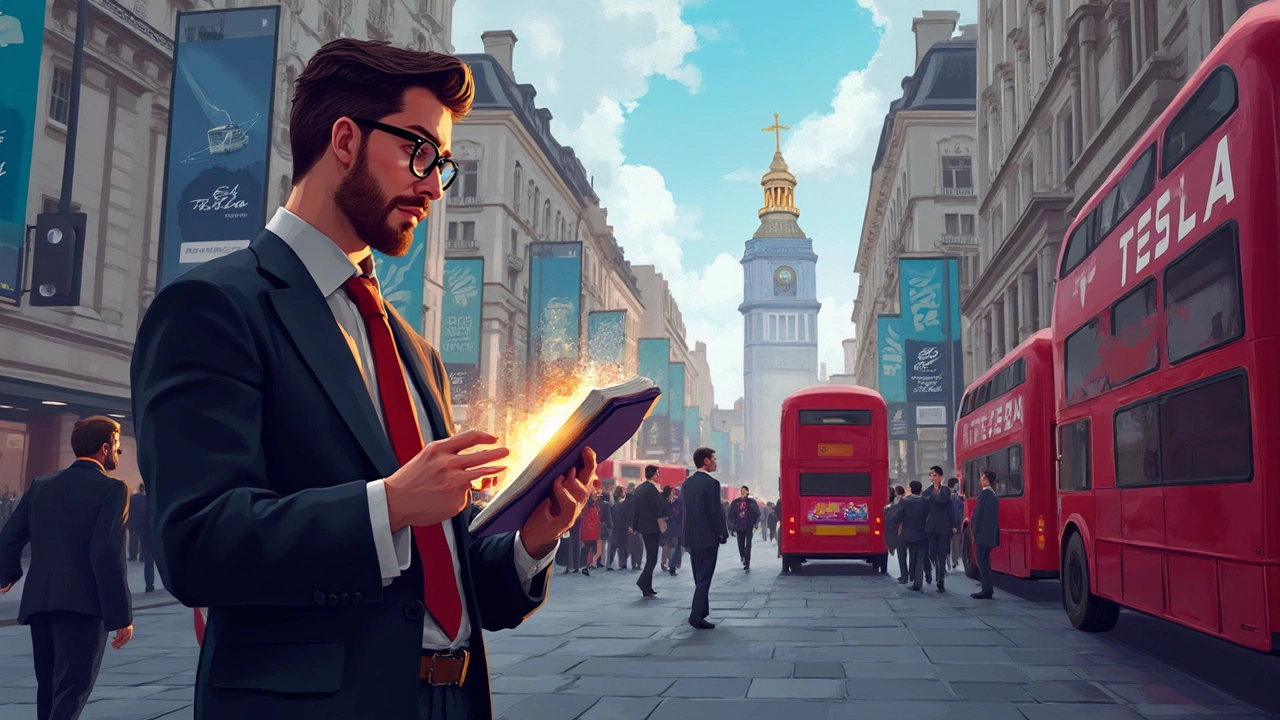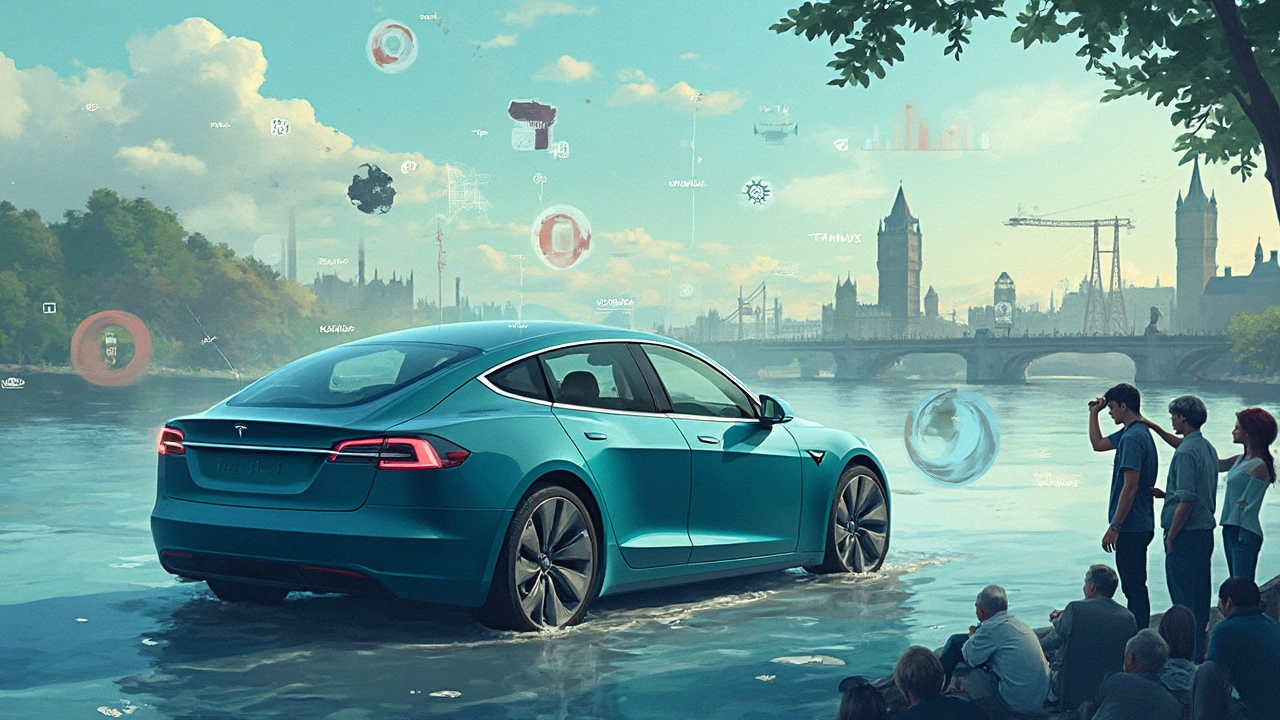Is Tesla Stock Worth Buying in 2025? Expert Insights, Analysis & Predictions
 Jun, 28 2025
Jun, 28 2025
Something wild happened back in 2012: if you’d bought Tesla stock then, you’d have watched your money explode into a mind-bending fortune—a total return well north of 15,000% as of today. That's not a typo. Fast-forward to 2025, and Tesla is no longer just a buzzy Silicon Valley upstart. It’s the name everyone knows, whipping up everything from electric cars to robot-powered factories and AI software. But after all the hype, crazy market swings, and Elon Musk’s relentless headline-making, is Tesla stock still a buy? Or, at these prices, is the party already winding down? Let’s dissect it piece by piece, so you can make sense of the madness and decide for yourself.
Tesla’s 2025 Story: Performance, Growth, and Big Bets
Everyone’s got an opinion on Tesla. Bulls will tell you it’s the Amazon of automakers—unstoppable, always innovating, led by a once-in-a-lifetime leader. Bears mutter about bubbles, stretched valuations, and growing competition. What do the actual numbers say?
Roll back to Tesla’s 2024 annual report: the company posted $121 billion in revenue, with automotive sales making up about 80%. Earnings per share landed at $5.56—well above where they were two years ago, even if profit margins slipped. Sure, the big-money “Full Self-Driving” package is still mostly an assistive tech, not the driverless revolution Musk loves to pitch. But Tesla did ship over 2.3 million vehicles worldwide in 2024, cementing its lead in electric cars. In China, the biggest seller of EVs, it’s locked in fierce rivalry with BYD, but it’s still a global force.
Tesla doesn’t call itself just a car company, and its numbers hint at why. Solar panels and a chunk of the home battery market (20% growth last year), a burgeoning insurance business, and of course the much-hyped Optimus robot. In 2023, Musk claimed Optimus robots could outnumber Teslas on the roads “within a decade.” Sound bold? Totally. But this sort of ambition (sometimes wild, sometimes realized) is what keeps investors talking.
Let’s look at the numbers the pros are trading on. Tesla’s price-to-earnings ratio (P/E) sits above 70, while old-school carmakers like Toyota and Ford hover in the single digits or teens. If Tesla were just a car company, that premium would look absurd. But investors are betting on much more: software, data, AI, and factories that get more efficient every year. As of June 2025, Tesla’s market cap floats near $900 billion, putting it ahead of every other automaker by miles, but it’s down from the trillion-dollar highs of late 2021. A year-to-date chart shows the stock climbing back from a nasty dip after a sluggish first quarter, to a gain of around 18% since January.
Here’s a quick look at Tesla’s latest key financials, fresh from their Q1 2025 release:
| Metric | Q1 2024 | Q1 2025 |
|---|---|---|
| Revenue | $23.3B | $26.4B |
| Net Income | $2.5B | $2.1B |
| Vehicle Deliveries | 422,875 | 468,211 |
| Operating Margin | 11.5% | 8.6% |
| Free Cash Flow | $1.9B | $2.4B |
As you can see, sales and deliveries ticked up, but margins are getting thinner—a sign of steeper price competition, especially as more legacy automakers (think GM, VW) flood the EV space. Still, Tesla’s ability to pump out profits and cash dwarfs its electric competitors. And for investors, that’s a big deal.

The Bull Case: Why Investors Still Love Tesla
Tesla fans never seem to run out of reasons for optimism. The company’s capacity to “future-proof” itself stands out. Unlike most carmakers who buy their computer chips and batteries, Tesla designs its own, giving it more control over costs and speed. Its factories? They’re not your dad’s old plant—with the company’s “gigapresses” and robots, a Model Y can be assembled in a fraction of the time it takes rivals. Less waste, fewer workers, cheaper cars. And in April 2025, Musk revealed a production run for the $25,000 “Model 2” aimed straight at the mass market (think: the pickup truck crowd and younger families).
But here’s what really makes Tesla’s vision unique: the software angle. Over 500,000 cars are running Tesla’s Full Self-Driving system in beta across North America. The company collects a mountain of driving data every day. If autonomous driving gets past regulation (a huge if, admittedly), Tesla stands to make software-like profits. They could sell the same code worldwide, no extra factory cost. Even at $200/month for its beta subscription service, that’s a recurring revenue stream most carmakers can only dream about. This is the strategy that shot Apple, Microsoft, and Google into the market cap stratosphere.
There’s more. Tesla’s “Supercharger” network isn’t just a perk for owners—it’s a giant moat. In 2024, Ford, Rivian, and even GM partnered with Tesla, agreeing to use their charging tech. Every new deal means more cars needing Tesla’s chargers, and more data for the company to analyze. That’s not something Ford or Toyota can replicate quickly, if ever.
The global EV market isn’t shrinking, either. According to BloombergNEF, electric car sales are still growing at a rate close to 20% per year, even as government subsidies phase out. In Europe, regulations have made internal combustion engines almost obsolete by 2030. China’s market is more cutthroat, no doubt, but Tesla is the only foreign player consistently making money there.
And don’t overlook Tesla’s approach to cost cutting. In 2024, they slashed prices on several models by up to 8%, which squeezed their margins, but drove record sales. For most car companies, that would spell doom. For Tesla, it was a strategic play—a sign of confidence in their efficiency and scale. And while Wall Street doesn’t always love these moves, the end result has been a bigger user base and more folks locked into the Tesla ecosystem. It’s the same playbook Uber ran in its early days—grab the market, build loyalty, worry about profits later.
TSLA’s stock isn’t for faint-hearted investors. It swings hard on Musk tweets, recall announcements, and sometimes just wild rumors. But over the long haul, that volatility’s been the secret weapon behind its legendary returns. The buy-and-hold crowd has been laughing all the way to the bank for years. Will that last? That’s the billion-dollar question investors are still debating.

The Bear Case: Risks, Red Flags, and Exit Signs
Not everyone’s cheering for Tesla. Critics say the stock is priced far beyond perfection, and even the smallest stumble could trigger a deep dive. Let’s tackle the big concerns.
First up: competition. Back in 2020, people said Tesla was years ahead. Fast-forward, and now BYD, Hyundai, and Volkswagen are closing the tech gap. BYD, especially, sold 3.4 million plug-in vehicles last year—more than anyone else. Chinese brands are racing ahead on price, quality, and range. The price war in 2024 cut into profits for everyone, and it's not letting up. Add in generous Chinese government support for homegrown brands, and Tesla’s growth in Asia doesn't look as safe as it did two years ago.
Another major issue: regulation. The U.S. and EU are both tightening rules on data privacy, self-driving claims, and battery recycling. Tesla’s big bet on Full Self-Driving can’t make real money until laws actually allow driverless cars. Some U.S. senators have called for stricter oversight after high-profile accidents involving Tesla software. If the tech hits a roadblock, that recurring revenue dream could become a giant disappointment. Tesla’s past recalls—like the 2.2 million-vehicle software fix in February 2024—also fire up regulators and chip away at public trust.
Margins are slimming, too. Take a look at Tesla’s trend: its gross margin dropped to 18% from over 25% two years ago. Not bad, but not invincible either. New factories in Mexico and India might cost more than expected, and supply chain shocks are always lurking. Remember, in early 2024, a chip shortage zapped production targets and hammered Tesla’s share price for weeks.
Now, about Elon Musk. His brand is, for better or worse, tied to Tesla. Wall Street usually gives him a pass for wild statements. But in early 2025, his focus has split with xAI, Neuralink, and Starlink. Some big investors worry about distractions, especially with the SEC keeping a close eye after Musk’s public comments about share sales, compensation, and… Mars. If he stepped down or got sidelined, a lot of the “Musk premium” could vanish from the stock price in a hurry.
Let’s not forget valuation. Even after dropping from its all-time highs, TSLA's P/E is lightyears above industry norms. If you strip away the dreams of robots, robotaxis and “AutoPilot Uber” network, the stock looks expensive, period. Legendary value investor Jeremy Grantham called Tesla a “magnificent bubble” in a January 2025 interview, saying he expects it to “re-rate” to more sane levels. Morgan Stanley’s latest research note says investors should brace for “extended volatility,” especially if sales growth stalls or China cracks down on foreign automakers.
For folks who care about dividends—that’s another reality check. Tesla doesn’t pay one. If you’re after steady income, other automakers or tech giants are more reliable.
So what’s the smart play? Here’s a checklist if you’re thinking about buying Tesla now:
- Can you handle wild swings in your portfolio? Only invest what you can afford to lose.
- Do you believe in Tesla’s tech leadership staying ahead for another decade?
- Are you OK waiting for dreams like robotaxis and humanoid robots to become reality?
- Does your timeline match Tesla’s erratic road to maturity?
- Is your portfolio diversified enough so Tesla can be just one piece of a bigger puzzle?
Sometimes, the best move is to buy small and add more as facts—not just hype—prove out. Or, if you’re nervous, hang tight and watch: let the next few quarters or product launches play out before jumping in. Either way, don’t bet the house. Tesla’s always proved it can surprise, but a company this exciting always cuts both ways.
